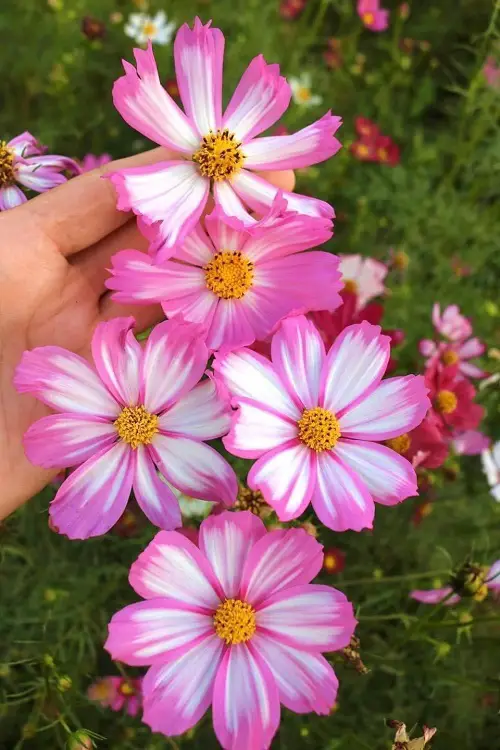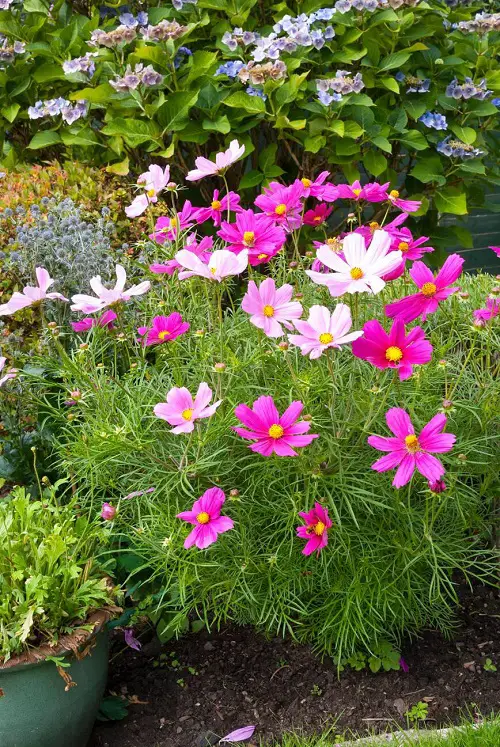What do Cosmos blooms signify? Here’s a lowdown on Cosmos Flower Meaning and Why Everyone Should Grow it! Read on.
The beauty of the brightly-hued daisy-like cosmos flower is undisputed, but is there something more to it? What sets this blossom apart in the far-reaching world of blooms? Read on to find out the meaning of the Cosmos flower and why everyone should grow it!
What is a Cosmos Flower?
Known as the “autumn cherry blossom” in Japan, cosmos is a genus of flowering plants belonging to the Asteraceae family. This includes other iconic flowers such as daisies, sunflowers, dahlias, and asters.
Inspired by its perfect, even-placed petals, this sun-loving plant gets its name from the Greek word “kosmos,” which means world, order, and harmony. Native to Mexico and southern parts of the US, it can grow up to a majestic height of 6 feet.
Its heart-stealing blooms take center stage with saucer-shaped, perfectly aligned petals appearing in hues of white, pink, and crimson anytime from late spring to fall!
The Journey of Cosmos Flowers

Celebrated as the cherry blossoms of fall (akizakura) in Japan, these flowers spread from the Americas to Europe during the Age of Discovery around the 16th century, when European explorers discovered and fell in love with the soft and silky cosmos flower.
These easy-growing self-seeders were so adept at adapting to different habitats that as trade routes expanded, they didn’t just stay in Europe. From the 19th century onwards, they found loving homes in Japan, Korea, China, and other nations of Southeast Asia, and today, they are found in gardens all over the world!
Cosmos Flower Meaning
Now that you know where they came from and how they spread, let’s dive into how the cosmos has inspired humans to find ways to endear themselves to its flawless blooms.
Given the meaning of its name, when someone gifts you a bouquet of cosmos flowers, they’re saying, “You mean the world to me.” Its star-like symmetrical petals also enhance its celestial and cosmic appeal.
And it’s no coincidence that cosmos flowers traditionally share October as their birth month flower with the iconic Marigold. October symbolizes change and evolution, so cosmos flowers have also come to signify new beginnings.
In Europe during the Victorian Era, amidst the popular practice of floriography (conveying messages and emotions through flowers), they symbolized joy and love. Victorians related the symmetry and balance of the blooms with a wholesome relationship.
Back in its home of Mexico, these flowers divined a harmonious union between humans, nature, and God. They are often used to call upon the spirits of the departed and used in the famous Day of the Dead festival.
These flowers are said to represent intangible aspects such as peace, tranquility, innocence, modesty, and joy. Being so resilient, they bless the most hostile environments with their blooms and signify the ability to rise above all obstacles!
How to Grow Cosmos?

Now that we’ve piqued your interest, we bet you want these extraordinary blooms in your garden! Growing cosmos is rather simple and can be achieved by anyone dipping their toes in the gardening realm. These flowers are not fussy about their needs, but it never hurts to fulfill their humble requests to really bring out the best blooms!
These drought-tolerant plants thrive in warm weather and neutral to slightly alkaline (7.0 – 7.5 pH levels) well-draining soil. They prefer warm temperatures, so find a sunny spot that receives direct sunlight for at least six hours daily.
Your cosmos will grow better from seeds. So, sow seeds directly about a quarter inch deep and about 14 inches apart. They’ll sprout anywhere from one to three weeks. You can buy young plants from a nearby garden center as well. Also, remember to deadhead these fast-growers for more blooms.
Why Everyone Should Grow Cosmost in the Garden?
Beyond its cultural, metaphysical, and historic allure, we love the cosmos flower for many reasons, especially in how becoming they are to any landscape. Let’s take a look!
1. They Come in Many Varieties
There is more than one type of cosmos. With over 30 known cultivars, Cosmos bipinnatus itself has the Sonata series with white, pink, and carmine blooms, the Seashells variety with fluted, tubular petals, or the tall Versailles type. Cosmos sulphureus is known for its fiery hues in red, orange, and yellow, while Cosmos atrosanguineus is deep scarlet with a chocolate scent.
2. Long-Lasting Beauty
If you don’t want your garden to go bland for more than half the year, plant Cosmos. This plant has a long blooming season and can blossom in almost every season except winter. Floral decorators also keep them on pedestals as these blooms retain their shape and charm even after being cut.
3. Perfect for Beginners
As mentioned before, the cosmos plant is very easy to grow and maintain, making it perfect for young gardeners and couch potatoes!
They can also grow in different climates—dry and arid, cool or warm and moist. They are hardy to USDA zones 2-11; of course, the growing time would be different and demand only the basics, such as full sun, draining soil, and moderate watering.
4. Pollinator Attractor
Looks like humans were the last to find the beauty in these all-rounder blooms. These saucer-shaped blossoms have been a go-to for the best pollinators, including butterflies and bees, since its very beginning. If you want a full-on healthy ecosystem rather than just a pretty spectacle, this is the plant for you!
5. Medical Uses
Cosmos is not just a pretty face; it has practical uses for humans as well. Traditional medicine incorporated the cosmos to treat jaundice, fever, and other disorders.
6. No Harm to Furry Friends
Plant your cosmos in pots, flower borders, anywhere in the garden, or even in your home without fear because these plants are not toxic to pets or humans!





